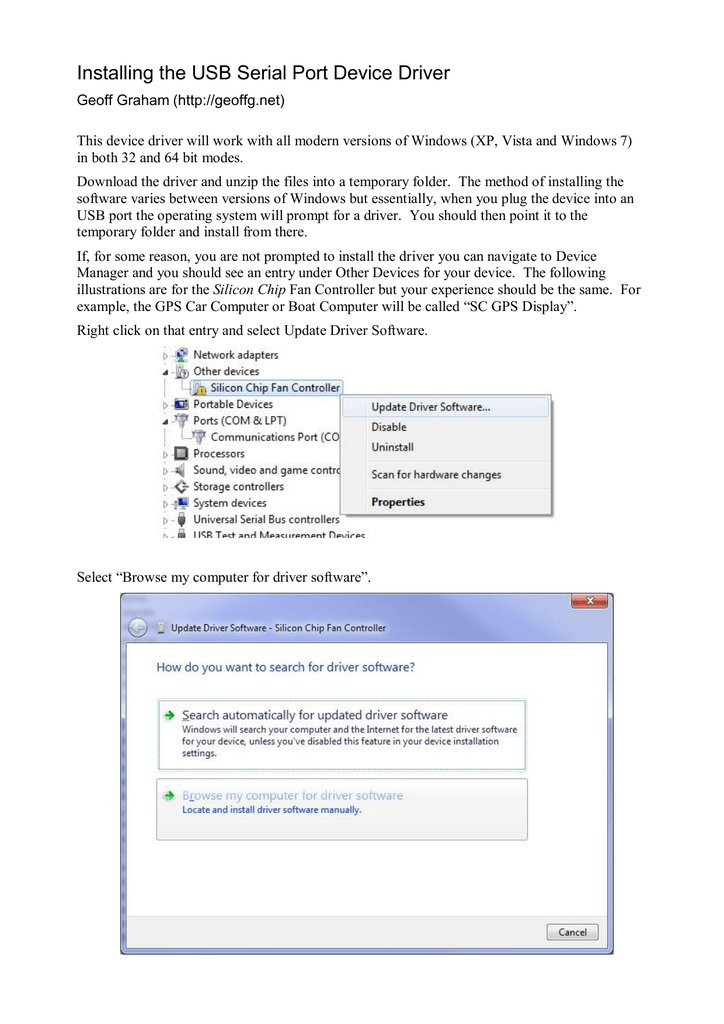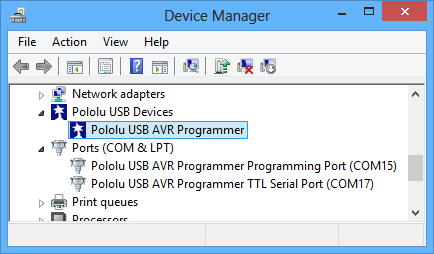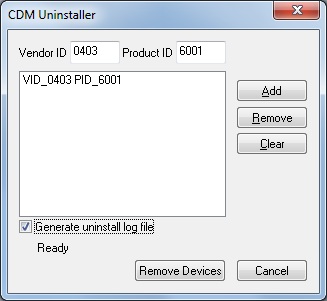Before you connect your Pololu CP2102 device to a computer running Microsoft Windows, you should install its drivers:
- Download the CP2102 drivers for Windows (4MB zip).
- IMPORTANT: You must extract the zip archive into a temporary directory. attempt to double-click or run any of the files until you have extracted them.
- Open the temporary directory and run the appropriate executable. If you have a 64-bit operating system, you should run pololu-cp2102-setup-x64.exe. If you have a 32-bit operating system, you should run pololu-cp2102-setup-x86.exe.
- During the installation, Windows will ask you if you want to install the drivers. Click “Install” (Windows 10, 8, 7, and Vista) or “Continue Anyway” (Windows XP).
- The installer should complete successfully.
Windows 10, Windows 8, Windows 7, and Windows Vista users: Your computer should now automatically install the necessary drivers when you connect a Pololu CP2102 device. No further action from you is required.
Download drivers for Synaptics PS/2 Port TouchPad input devices (Windows 10 x64), or install DriverPack Solution software for automatic driver download and update. FTDI USB Serial Port driver is the software that helps your operating system to communicate with USB Serial Port devices. Get the latest driver Please enter your product details to view the latest driver information for your system. MIDI Port Driver.; 2 minutes to read; D; D; In this article. The MIDI port driver manages a MIDI synthesizer or capture device. The adapter driver provides a corresponding MIDI miniport driver that binds to the MIDI port driver object to form a MIDI filter (see MIDI and DirectMusic Filters) that can capture or render a MIDI stream. The driver must be numbered as '2.0.2.8' and dates accordingly If the driver was not installed, remove the Serial adapter then run 'PL2303DriverInstaller.exe' again. Follow directions in Device Manager to download the correct driver. CP can be used to migrate legacy serial port based devices to USB. During the installation, Windows will ask you if you want to install the drivers. USB to UART Bridge VCP Drivers – Silicon Labs. Windows 8 device manager showing a Pololu CP device. The installer should complete successfully. Event character support Line break transmission.
Windows XP users: You need to follow steps 6–10 for each new device you connect to your computer.
- Connect the device to your computer’s USB port. Your computer will detect the new hardware and open the Found New Hardware Wizard.
- When the Found New Hardware Wizard is displayed, select “No, not this time” and click “Next”.
- On the second screen of the Found New Hardware Wizard, select “Install the software automatically” and click “Next”.
- Windows XP will warn you again that the driver has not been tested by Microsoft and recommend that you stop the installation. Click “Continue Anyway”.
- When you have finished the Found New Hardware Wizard, click “Finish”.

If you now go to your computer’s Device Manager and expand the “Ports (COM & LPT)” list, you should see “Pololu USB-to-Serial Adapter” as one of the COM ports.
Windows 8 device manager showing a Pololu CP2102 device. |
|---|
Some software will not allow connection to higher COM port numbers. If you need to change the COM port number assigned to your USB adapter, you can do so using the Windows device manager. Bring up the properties dialog for the “Pololu USB-to-Serial Adapter” COM port and click the “Advanced…” button in the “Port Settings” tab. From this dialog you can change the COM port assigned to your device.
Related products
| Orangutan USB Programmer |
| Pololu USB 16-Servo Controller |
| Pololu USB-to-Serial Adapter |
| Orangutan X2 with VNH3 |
| Related Config File Sections |
|---|
| pololu_maestro: |
| servos: |
MPF supports servos connected to Pololu Maestro servo controllers. Each Maestrocan control multiple servos, with models that control 6, 12, 18, or 24 servos.
Here is anexplanation video by the pinball amigoson how to setup a pololu maestro (and more).
1. Install the Pololu Maestro drivers¶
Just like any hardware device you connect to a computer, you need to installthe drivers so your computer can see it. It is easier to do the initialhardware configuration on a Windows PC. Follow the “Getting Started” section of thePololu Maestro Servo Controller User’s Guide.You will need to set Maestro’s serial mode to USB Dual Port on the Serial Settings tabof the Maestro Control Center.
2. Configure your hardware platform section¶
Next, you need to tell MPF that you want to use the pololu_maestro platformfor servos. (MPF supports several different models of servo controllers.)
To do this, add servo_controllers:pololu_maestro to the hardware: sectionof your machine-wide config file, like this:
This tells MPF that you want the default servo platform to be pololu_maestro.If you happen to be using multiple different types of servo controllers, you canoverride the default by adding a platform: entry to individual servo devices(just like any device in MPF that can have its platform overwritten in the deviceconfig).
3. Configure the serial port¶
Next, you need to tell MPF what port the Maestro is connected to. (Note thatwhen you plug in the Maestro, you’ll see two serial ports appear. You want touse the first one (the lower number).

Add a section to your machine-wide config like this:
On Linux or Mac, it will probably look like this:

4. Add your servo devices¶
Now that all your hardware is configured, you can add the actual servos to yourmachine config. In MPF, servos are just like any other device (light, LEDs,coils, etc.) You add a servos: section to your config, and then create subentries in there for each servo you have.
For example:
Okay, there’s a lot going on in there. Let’s break it down.
First, all these config options are explained in-depth in the servos: sectionof the config file reference. But let’s point out a few Maestro-specific thingshere.
The number: of the servo is simply which channel on the Maestro board eachservo is connected to. These numbers start with 0, so a Micro Maestro 6 supportssix servos via numbers 0-5, the Mini Maestro 12 supports twelve servos numbered0-11, etc.
All servo positioning in MPF is controlled via a floating point value from 0.0 to 1.0.In other words, if you tell a servo to go to position 0.0, that will be one endof its motion, and position 1.0 will be the other end. A value of 0.4 will tell theservo to move to a position that’s 40% along from the start limit to the stop limit, etc.
So that’s universal, 0.0 - 1.0, throughout MPF.
The way servos actually move to a position is that the servo controller sendsa series of microsecond-level pulses which the servo reads and can thentranslate into a certain position. The actual value of these pulses variesdepending on the servo controller and servos you actually have.
You may also set servo_min and servo_max if the servo is trying to move beyond its(hardware) limits when setting it to position 0.0 or 1.0. Those two values willbe applied to all positions. For instance, if you move it to 0.0 it will actuallymove to servo_min (0.2 in the example) and to servo_max for 1.0 (0.8 in the example).Everything in between will be interpolated.
The Pololu Maestro servo controllers can accept speed and acceleration settingswhich specify how fast the servo moves to the new position, and how (or whether)it accelerates and decelerates when starting and stopping. If you want to use theseadd the speed_limit: and acceleration_limit: settings to your config.
5. Using the servo in your game¶
The servo’s position: setting contains a list of numerical servo valuesmapped to MPF events. So to move a servo in your game, just add the positionyou want to the list and then post that event.
Again, see the servos: section of the config filereference for details.
6. Future enhancements¶
Download Pololu Port Devices Drivers
Multiple Pololu Maestro controllers can be chained together (viaa single USB port). We don’t have support for that yet. (It requires addingand additional address setting to the servo config.) If you want that,let us know and we’ll add it.
What if it did not work?¶
Download Pololu Port Devices Driver Updater
Have a look at our hardware troubleshooting guide.